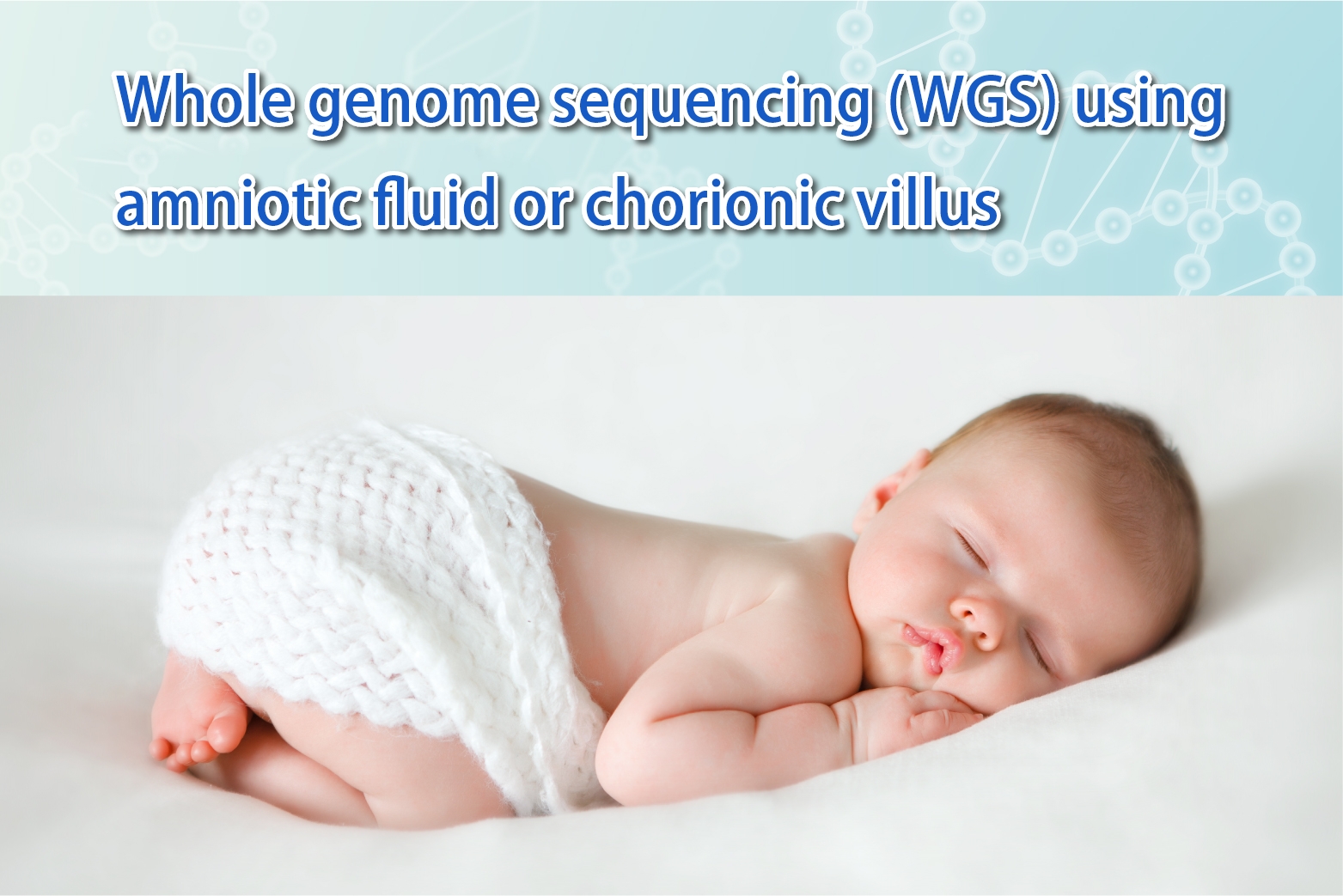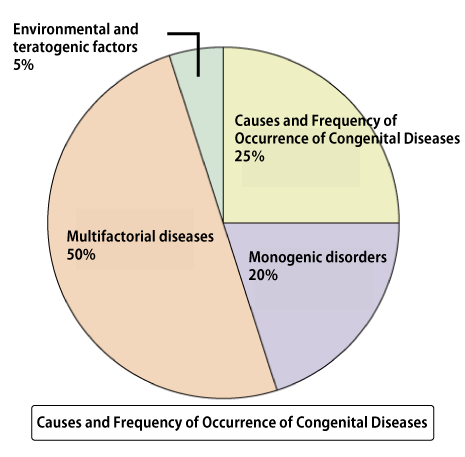

Whole genome sequencing (WGS) using amniotic fluid or chorionic villus
Whole-genome sequencing (WGS) using amniotic fluid or chorionic villus is a test that can detect single bases that make up genes early in pregnancy to see if there are mutations that cause congenital diseases.
3-5% of babies are born with congenital disorders (congenital abnormalities). 25% of these are caused by chromosomal abnormalities (trisomy, monosomy, translocation, etc.). Congenital disorders caused by a single gene account for 20%, almost the same percentage as those caused by chromosomes. Furthermore, congenital abnormalities caused by multiple factors (a combination of environmental and genetic mutations) account for up to 50%. Therefore, it is thought that the percentage of congenital disorders caused by genetic mutations is higher than those caused by chromosomal abnormalities.

In addition, the frequency of chromosomal abnormalities (trisomy and monosomy) increases with age. Therefore, it has been reported that when the patient is young, there is a higher risk of congenital abnormalities caused by gene mutations than chromosomal abnormalities.
WGS (whole genome sequencing) using amniotic fluid or chorionic villus is a test that can check for mutations that may cause disease, including not only inherited mutations from parents but also newly occurring mutations, in the early stages of pregnancy by examining all genes at the base sequence level.
Congenital disorders include more than just trisomy and monosomy.
It is known that 3-5% of babies are born with congenital diseases.
25% of these are caused by chromosomal abnormalities (trisomy, monosomy, translocation). Trisomy is a condition in which a pair of chromosomes becomes three. Human chromosomes usually have a pair of two chromosomes. However, in trisomy, an extra chromosome is present. A well-known congenital disease with trisomy is Down syndrome. In Down syndrome, there are three copies of chromosome 21. Monosomy is the opposite, in which there is only one chromosome missing. For example, in Turner syndrome, there is monosomy with only one X chromosome, which is a sex chromosome. Approximately half of congenital diseases are caused by multifactorial diseases (a combination of genetic mutations and environmental factors). As a result of advances in genome analysis, mutations related to diseases have been found, even in diseases that were not previously thought to be caused by genetic mutations, such as lifestyle-related diseases. For this reason, many diseases are now considered to be multifactorial (complex) genetic disorders in which individual gene mutations alone do not lead to disease, but develop when multiple mutations are combined.
On the other hand, the percentage of congenital diseases caused by specific gene mutations is 20%, which is slightly lower than chromosomal abnormalities such as trisomy. However, considering that multifactorial diseases are influenced by gene mutations, congenital diseases caused by some kind of gene mutation may occur much more frequently than chromosomal abnormalities.
In younger people, genetic disorders caused by single gene mutations are more common
It is known that the frequency of numerical chromosomal abnormalities depends on the woman's age. As a woman gets older, the percentage of eggs with numerical chromosomal abnormalities increases. Therefore, as a woman gets older, the possibility of fertilized eggs and fetuses having trisomy or monosomy increases. Therefore, NIPT (new type prenatal diagnosis), chorionic villus sampling, and amniocentesis are recommended for women over 35 years old.
The risk of numerical chromosomal abnormalities (trisomy and monosomy) is not as high for younger people as it is for older people. Rather, there is research that shows that congenital diseases caused by single gene mutations are more frequent than trisomy and monosomy for younger people.
Diseases caused by single gene mutations rarely cause abnormalities in the morphology of the fetus, and abnormalities may be found by ultrasound examination. However, regular PGT-A (PGS), NIPT, chorionic villus sampling, and amniocentesis cannot detect single gene mutations. As a result, abnormalities are almost always found after birth.
Carriers of genetic disorders
Diseases caused by a single gene mutation are inherited in a recessive manner. In this inheritance pattern, if a normal gene and a gene with a disease-causing mutation are paired, the disease will not develop. This state is called a carrier. The disease will develop only when both genes with the disease-causing mutation are present. It is not possible to determine whether a person is a carrier from appearance, as the person will not develop the disease. Therefore, if two carriers of the same genetic disease happen to become a couple, there is a 25% chance that they will inherit the gene with the disease-causing mutation from their parents and develop the disease. If you have been screened for carriers in advance and know that you are a carrier, you can use PGT-M (preimplantation genetic testing) to select an unaffected embryo and become pregnant.
Mutation frequency
However, carrier screening is not a panacea. Genetic mutations that cause diseases are found every day, so carrier screening may not cover all genetic mutations that cause diseases. Furthermore, mutations may occur, and even if both parents have normal genes, children may have congenital abnormalities. The probability of a mutation occurring is very small, at 1×10-8per base . However, the human genome consists of 3×10 9 bases. Therefore, new mutations are calculated to occur in approximately 30 bases (30 locations) per generation. Furthermore, research has shown that the probability of mutations in men increases with age, just like chromosomal abnormalities in eggs. Not all of these will cause congenital diseases, but depending on the location of the mutation, there is a possibility that congenital diseases may develop. Naturally, these new mutations cannot be prevented by carrier screening or PGT-M.
Mutations that may cause congenital diseases can be detected before birth
Congenital abnormalities caused by gene mutations, rather than chromosomal abnormalities, cannot be detected by PGT-A (PGS), NIPT, chorionic villus sampling, amniocentesis, or ultrasound. However, WGS (whole genome sequencing) examines all genes at the base level, making it possible to detect mutations that may cause such congenital diseases.
How WGS works: using amniotic fluid or chorionic villus
In WGS, fetal DNA is first extracted from chorionic villi or amniotic fluid. This extracted DNA is then run through an NGS (next-generation sequencer) to examine the entire genome sequence, base by base. The sequence is then compared with the parental sequences to check for mutations that may cause genetic diseases. The genome consists of exons, which are the blueprints for proteins, and non-coding (non-protein blueprint) parts, such as introns, which connect them. If there is a mutation in the exons that are the blueprints for proteins, normal proteins are often not produced. Although the non-coding parts do not become the blueprints for proteins, they contain parts that control the amount of protein and where and when it is produced. Therefore, mutations in the non-coding parts may also cause genetic diseases. In this WGS, the entire genome, including the non-coding parts, is examined for mutations.
Limitations of WGS using amniotic fluid or chorionic villus
However, WGS also has limitations. Some mutations have unknown clinical impacts. In addition, future research may change the judgment. Therefore, a mutation that is currently thought to be unrelated to a disease may be found to be related to the disease in the future, or conversely, it may be found to be unrelated. In the case of mosaics with mutations in only some cells of the body, the mutation may be overlooked, or the disease may not develop even if a mutation that causes the disease is detected.
Furthermore, since the penetrance and expressivity of each genetic disease differ, the disease may not develop even if a mutation that causes the disease is detected. NGS is not yet a perfect technology. Therefore, although the accuracy of reading the base sequence is very high, it cannot be said to be 100%, and there is a possibility that a mutation may be overlooked or that a possible disease may be mistakenly determined.
Inquiries │
We accept inquiries by email. Tokyo · Osaka │ O.G.M.S.

Prenatal Test for Determining Fetal Sex
english_help@ogms.biz
The email address may vary depending on the content of your inquiry. Please check the mail address on each service page.
There may be a delayed reply to inquiries received at night, weekends/holidays, winter and summer break.
It may take some time to reply depending on the nature of the inquiry.
Inquiries │
We accept inquiries by email.
There may be a delayed reply to inquiries received at night, weekends⁄holidays, winter and summer break.
It may take some time to reply depending on the nature of the inquiry.
